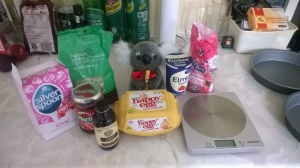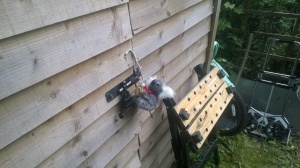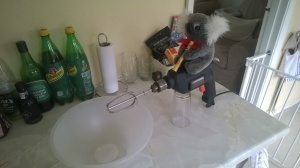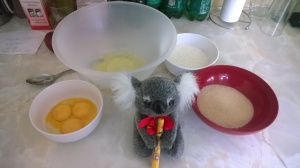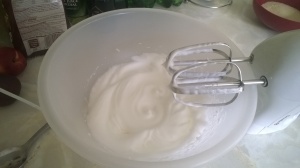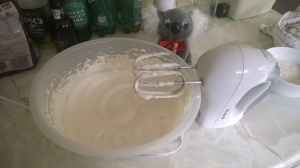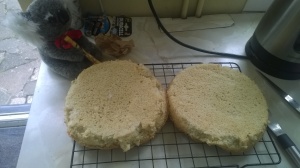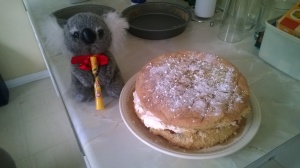Hello Koala fans!
This week’s entry is late because I was away last weekend. As I’ve mentioned before on here, I’m a member of a board gaming group and last weekend was one of our bi-annual gatherings. Although I didn’t get a chance to bake anything before heading up, the Koala tagged along for the ride too. It was held in Glasgow (in Scotland, for our readers outside of the UK) and it was really good fun seeing all my friends again. It was slightly disappointing for the Koala, as he’d taken it into his head to go Haggis hunting – the less said about *that*, the better. I mention this because I had the opportunity to sample some foods I’d never tried before. On the Friday night, we went to a Russian restaurant a stone’s throw away from the meet up venue. I didn’t know much about Russian cookery, aside from the stereotypical borscht. It was quite interesting – many of the dishes were stews, dumplings and filled buns called pirozhki. Of particular note, Russian food involves a lot of panackes, called blintz or blini. The ones I had were filled with potatoes, onions and mushrooms in a creamy sauce and were really delicious. Of interest to you good people is this:

It appears to have several different names; on the menu I chose it from it’s referred to as “Kutuzov Cake”. It’s quite unusual in that it has lots and lots of thin layers of cream and sponge, rather than the traditional thick layers you see in things like Victoria Sponges and gateaux. It reminded me more of a tiramisu than anything else. It was, however, really really good and I’m tempted to give it a try myself in the next few weeks. If you can’t wait that long, the blog I borrowed the image from has a fantastic step by step guide:
http://natashaskitchen.com/2012/10/30/chocolate-spartak-cake-recipe/ Note: Both the image and recipe are the property of Natasha’s Kitchen – please do not use or copy either of these without permission.
“But Koala”, you may be thinking, “You were in Scotland! Why didn’t you sample some of the traditional local cuisine?!” The answer is that I did – I sampled one of Scotland’s most famous national dishes. Not haggis, not black pudding, not finest smoked salmon straight from the lochs. No. This is what Scotland’s second most famous delicacy looks like:

The Deep Fried Mars Bar. Death by Calories. A guaranteed heart attack in confectionary form. This demon has many different names but Glasgow is credited as the spawning places of this culinary abomination. I have had this on only two occasions. Once was in my local chip shop as a teenager, which immediately resulted in my being sick (the red wine and beer I’d unwisely drunk together before that was merely a catalyst). The second time was last weekend in Scotland. I was visiting the gaming group with one of my best friends from overseas (and a big hello and many hugs to Sari if she’s reading) and coerced her into trying some, along with a Swedish friend that had come along as well (and hello to Teddy if he’s reading – hope the rest of your trip is more merciful to your cholesterol level! :p). I’d like to apologise to both of them now for inflicting the DFMB on them but I guarantee it’s a taste not swiftly forgotten!
Prior to my trip to Scotland though, it was Father’s Day in the UK. Those of you with good memories will remember I made my dad a chocolate cake last year, so this time I tried something a little different. Most of the cakes I make on the blog are quite rich, usually containing masses of cream, butter, sugar, alcohol or all of the above. Mum suggested that this year I could try something alternative and try to make a light cake. A sponge cake with simple flavours, a very small amount of filling and a soft, delicate sponge. I went with a recipe from my Clandestine Cake Club book for “Featherlight Cake”. The ingredient list is much the same as most other sponges; the trick is maximising the amount of air that gets caught up in the sponge.
Before I could ask him what he meant by that, the Koala had fled up the garden.
In the time it took for me to blink, the Koala had vanished again, running back into the kitchen with cackling marsupial laughter filling the air….
Important legal disclaimer: Do *NOT* use industrial power tools to mix cake batter. Do not allow insane Australian bears to do this either. Once I’d plugged the whisk back into the correct appliance, it was time to set to work. Because it’s important to keep air trapped in the mixture prior to baking, you need to separate the ingredients out so that each one can be added quickly. In the photo below, you’ll see the four bowls containing egg white, egg yolk, plain flour and golden caster sugar.
The initial steps put me in mind of making the meringue topping for the key lime pie. The first step involves whisking the egg whites until they start to form peaks. When you are whisking, be sure to move the whisk all through the bowl, otherwise you wind up with a wonderful foamy layer on top and egg white underneath.
You’ll know when you’re on the right track because as the air bubbles get trapped in the egg white, the mixture will become less and less transparent and starting taking on a white colour instead. You should also start to see the little ridges and dips from the trail the whisk leaves in the mixture. Once the egg whites have started to speak, whisk in the egg yolks one by one, followed by small amounts of the sugar. If you dump the whole lot in at once, it squashes the egg white and knocks all the air out of it. A little bit at a time and then the flour is very, very gently stirred in as well.
It’s still a better ratio than 0% ingredients, 0% air, 100% koala. Once everything is mixed, the batter goes into the cake tin. It’s a similar arrangement to adding the ingredients: gently pour the batter into the cake tins because (you’ve guessed it) if you tip it in from a great height the air escapes from the mixture. I think that’s part of the reason why this is called a featherlight cake. Partly is because of the texture of the sponge at the end but it’s also due to the way you prepare everything; slow, gentle, cautious – a light touch.
The sponge mixture turned out very, very light, which was a good thing as far as eating it went but it did make removing them from the tins rather more difficult. Next time I think I will line the edges of the tin, instead of just the base. A little trimming with the knife and some whipped cream later, the final result looked pretty decent:
It went down well with my dad and the rest of the family and over all it was a very good recipe to follow. Cheaper to make than a sponge containing butter, lighter texture and a nice, orderly way of preparing the whole lot. It’d be interesting to see how a chocolate version of this cake turned out – would the cocoa affect the mixing process? Would it be lighter or denser than a plain vanilla sponge? Perhaps in future we’ll find out. For scientific reasons only, of course.
*****
Shortly after arriving safely back home in Finland, Sari sent me this picture she’d found and I’d like to share it with you folks too. It’s a fine demonstration of reflexology in small cuddly animals:
“I don’t think you’re a qualified masseuse….”
See you soon folks!
